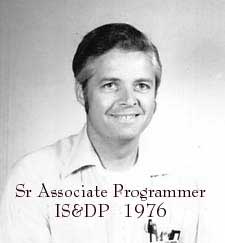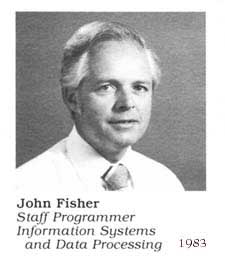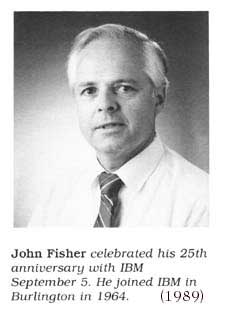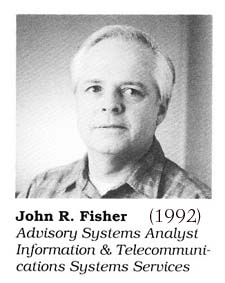John's IBM Work History
In 1964, I began my IBM career on a Saturday morning in Building 962, the only
building at IBM Burlington, and drove to Endicott, NY on Sunday for 3 months
of on-the-job training on the SMS Standard Modular System. SMS cards were Embossed,
Custom Wired, and then all the Resistors, Capacitors, Transistors and other
discrete components were inserted onto the cards. My job was to maintain all
the electromechanical machines that were required for these tasks; the Univert’s
and Unisert’s and the T-05 and T-18 Transistor Inserters. The product was
the IBM 7090 and 7094 Computer Systems, the most powerful in IBM at the time,
which had 32K of 36 bit ferrite core memory, with a speed of .5 Megahertz .
Programs were written in Fortran and Cobol on punched cards, which were read
into the computer and written to the tape drives. The jobs were later read in
from the tape drives, and executed on the all solid state and fully transistorized
CPU and data was written to output tape drives; which were later used to print
to the high speed printers. The 7094 System cost approximately $3.5 million
dollars. The 7090 replaced the IBM 709 System which was all vacuum tubes.
In 1966 I moved to the Reed Switch / Reed Relay area and maintained
the Post Adjust Machines and the Gray Elephant, the pet name for a Reed Switch
Test System which was manufactured using hundreds of Contact Relays, IBM Burlington’s
first product in 1957. This proved to be a nightmare to debug at times due to
sticking relays etc.
1967: After a training class on the IBM Selectric Typewriter,
I moved to maintain the Micro-Punch machines which were used to program the
TROS tapes (Transformer Read Only Storage) which provided the first ROM memory
for the System 360 Systems.
In 1968 Moved into Test Equipment Services and Tom Ruane was my first level
manager. Tom was a fast-tracker and went on to be the Endicott Plant Manager
and retired about 8 years ago.
Burlington began its first memory chip, a 64 bit chip called Phase 2. I learned
and maintained the MAT I system, the first Memory Array Tester in Burlington.
It had a UEPB (Universal Electronic Plug-Board), which had 8K of core memory
that was loaded by paper tape. It was driven by the IBM 1130 System which was
a 32K core memory machine and it had 5 removable 1 Meg hard drives and an 1132
Printer which had 132 printwheels and it almost walked across the floor when
printing.
I went to San Jose for a month and learned how to repair
the 1130 system, which saved us from paying for CE coverage. I then went to
Washington, DC for a month and learned the 1800 System which was similar to
the 1130 but also had “V” Core which meant that the system could run
a ‘virtual job’ in special memory, while the normal stored program
was running. This meant that us maintenance tech’s could run the “Hi-Lo”
program and determine who would buy coffee, without interrupting the main program
which was used for monitoring the process line in Burlington. My first programs
were written in 1130 and 1800 assembler and were used for testing the systems.
I was on the Team that built and tested the first CAVE tester in Burlington,
which was to be used to test Flat Film Memory (looks like a mirror). The project
was cancelled.
I went to Canoga Park, near Los Angeles for 2 weeks to learn
the AAI Tester which was very powerful and had 99 test points versus 12 on the
MAT I Tester.
In 1970 I began installing TCU adapters (Transmission Control Unit), a very
high speed communication link that Burlington used for almost 30 years) in the
MINIMAT, MAM DC, MAT III DC SMU and MAT III AC SMU etc. Later I learned the
TCU Control Unit and maintained that for several years with Abner Lord who was
my lead technician for many years.
I moved into Test Equipment Build on Pearl Street and began building and testing
the DC and AC cards for the SMU Testers. I wrote my first Fortran program for
Joe Carroll that tracked all the Work-Orders in Test Equipment Build.
Maintained the MAT III DC SMU Testers
In 1971 IS maintained a Tool Maintenance Program for Test Equipment but they
had a limit of 30 tools maximum. We were adding many tools and needed more capability,
but IS said it would take years. Dick Romick and I wrote the TEM (Test Equipment
Maintenance) program in APL in 2 weeks and continued developing it along with
the TEU (Test Equipment Utilization) for product tracking on our testers. Later
on, IS estimated a 3 month period to replace our system but it took them 3 years
to complete the CEM System, which later evolved into BUDS and BESS.
In 1970 I also wrote a Work-Order program in APL for another area.
Dr Charles Stapper obtained one of the first Helium-Neon Lasers for the M120I
Flat Film project and I performed daily calibrations on the laser system for
a year.
On 15 Sep 1973 I was promoted to Tech Associate Engineer (first exempt level)
and went to Fishkill for 9 months with a 9 man maintenance Team composed of
digital and analog electronics, cryogenic and mechanical techs with the task
of building and debugging one of 4 APSRA E-Beam Mask Writing Systems. It was
powered by a 370/145 system. The system had Emitter Coupled Logic and its memory
speed was 23 nanoseconds!!! It was the most complex system I had ever worked
on in my life. The other teams were from Fishkill, Essonnes and Sindelfingen
and the competition to be completed first was fierce. Pre-processing programs
for the system were only a dream at that time, but a Fishkill engineer wrote
a program that displayed IBM on the wafer on the oscilloscope on the system.
Not to be outdone, my manager, Dave Meunier encouraged me to write one for Burlington
and so I punched up a new card deck and loaded it into the system and Burlington
had the only system displaying the “Playboy Bunny”! We brought our
system back to Burlington in June of 1974 and the project was cancelled.
I did not want to go back to maintaining testers anymore and jumped at the Retraining
Opportunity to be a programmer. I went to a 3 month class with Al Kerner and
others and learned 360 assembler and system/7 macro assembler, JCL etc.
I began working for Dwight Bisonnette and Jack Martin using SPL/1 (Sequential
Programming Language/1) in the B970 Fab on Evaporator Tools, and Ion Implant
Tools etc. Soon I was leading the Process Team and then the SPL/1 System/7 Operating
System Support team.
Promoted to Sr Associate Programmer.

One deviation from this area was a fun APL job on the 5110 APL/BASIC 64K
computer (IBM’s first PC?) The Evaporator tools in the fab used a DEC PDP/8
computer and it was loaded by paper tape. When any outage occurred it took 20
minutes to read in the paper tape, much too long. I picked up a APL PDP/8 assembler
compiler from Alan Jones in the IBM Glendale Lab, and wrote the code to handle
all the macro statements. We were then able to code and compile PDP/8 code using
APL and writing to a magnetic tape, which could be loaded into the evaporator
tool in 2 minutes. I spent several months in Fishkill learning
the newest Ion Implanter and brought it to Burlington. The Current Integration
was updated by the Brookhaven Lab in NY and I had to rewrite about 8k of assembler
code to complete the integration.
October 16, 1978: I joined the MCS/1 Team working for Barbara Floyd and Ron
Barker was the Project Leader. I coded the BFMSUPDT module which read data from
BFMS and updated the MCS Lot Records on the MCS Cluster. I also worked with
Linda Brenner on STARTLOT, because the BFMSUPDT and STARTLOT backend code was
the same. She wrote the Screen and I added the update code.
Carl Potter created MCS 80 Cluster I, Linda created Cluster II and I
created the Cluster III operating system, all were used in the B963 CP (Current
Product) Line.
I took over the maintenance of the APL Routing System from Ron Barker and after
hitting the 64K limit, I designed the MCS/1 MVS/TSO routing system which was
coded by Sue Strong and Scott Simmons.
Our initial DB system was a S/38 and I wrote DSPOOL on the ICS System which
wrote data to a 1 Meg 8 inch floppy diskette, which was later read into the
S/38. As the productions lines grew, this was time-consuming and so later, Kathy
Grise and I wrote the BiSync program which gave us real-time communications
between the ICS and S/38 MRS System.
In 1982, Hans Heikel joined the MCS Team. Hans has always provided the team
with much fun and insight. His best achievements were the “Get Out Of MCS
Free Card”, the “Mind Meld”, and “the Mask & Backbone”
figure. His most unique code was “enhanced Overlays on MCS/1” and
the “Big Boy” overlay area flusher. There were many more but my mind
fails me lately.
In 1983 I was promoted to Staff Programmer

MCS went into the B966, B970 and B973 Fabs. I was the Project Leader for putting
MCS into the BEOL. My sister Patricia was the BEOL Leader. It was a big job
and took about a year and was successful.
In 1987 I headed up the BFMS Loss Code gating Project, the last big effort on
the MCS/1 system which now used almost 80 Series/1 Systems networked together
using CHAT; and PCIS modules for host networking like PCOS2135 etc. The whole
MCS Team created or modified about 120 assembler code programs to get this piece
done.

1988 was the year of SIMPLE or LANCE which ended up as MCS/2 on 3 4381-T92
mainframe systems. First customer was the EPL Line. John Wetzel, Judi Maculan
and Dennis SteMarie were the principal MCS/2 Application coders. We migrated
most fabs to MCS/2 and had only B973 to go in 1992 when I moved to the SWIM
System which used Smalltalk. I did the manufacturing data integration to the
MANSIM system with Bob Moore.

In 1993 Al Kerner asked me to lead the Integration of LMS from the IE dept
into ITSS. This was accomplished and the team consisted of Barry Gerard, myself
and Homer Wesolowski. LMS was only on MVS and VM and had no intersystem communication
capability at all. Basically, it wrote to a VSAM database and MCS/2 read the
data from the database and delivered it to the operator. I began the RFS effort
with Daria Dooling and Homer and eventually it was all picked up by Dan Newbury
who integrated it with Ian Govetts XMAN application. This interface is the core
of the LMS communication system today and resides mainly on RS/6000 system running
AIX and using the AFS file system. Most of the VM and MVS apps are now running
on AIX.
A good challenge and a fun job was the LMS XML Parser that I wrote in order
to deliver XML data to the IOI Application.
In August of 2001, Denis Brochu was laid off and I had 3 days to pick up the
SiView 300mm BOM Analysis effort; and then the AsmView BOM effort.
In January of 2002 I began the ASI/ RTD analysis effort, taking over from Eric
Bokelberg who took over from Russell White. This involved the AsmView data integration
to the RTD application which exists on a SUN System running Solaris8.
In 2002 I was selected for an IGS Resource Action and was very happily forced
into retirement which begins on August 1st.
So ends my IBM Career. The highlights have always been the great people that
I have worked with.




